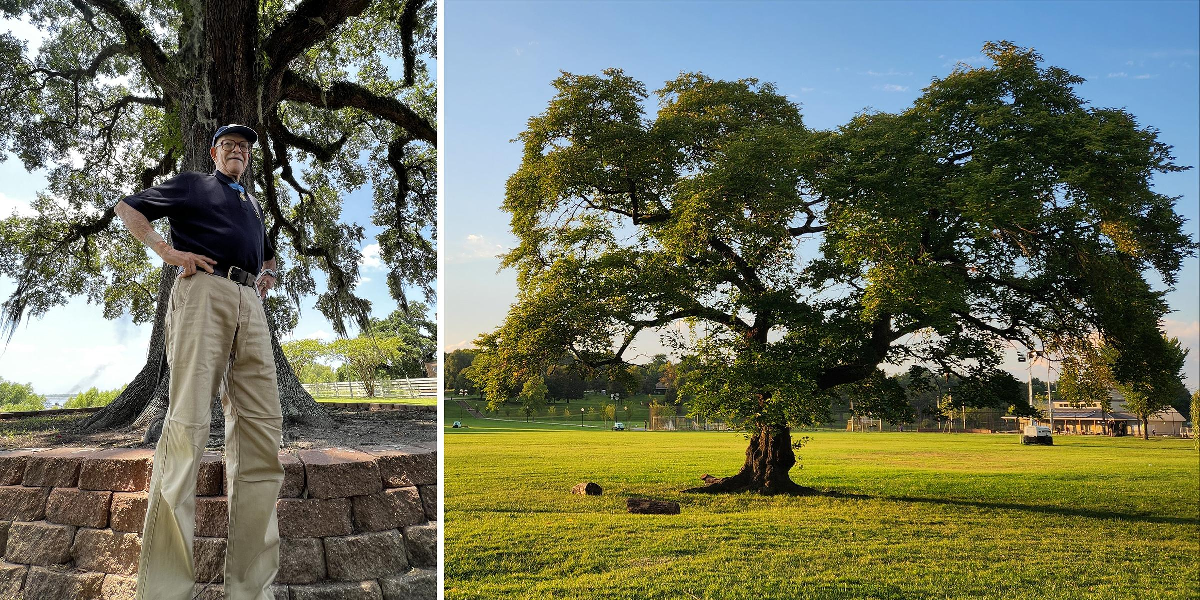Mentally and Physically, Trees Make a Difference to Health
May 24, 2024 at 11:53 a.m.
During my dad's recent hospital stay, I witnessed the healing power of trees.
He was assigned to a room that looked out at a bleak brick wall. Needless to say, he didn’t like it. He quickly grew tired of brick walls and began asking to see trees and get fresh air. He believed that spending time in nature would help him feel better - and his instincts were right. With permission from the nursing staff, we found a way to take him outside. The moment we were surrounded by the green canopy of trees, his mood improved. That became our daily routine, and I’m certain the presence of trees sped up his recovery.
More than instinct, studies have consistently shown that trees are beneficial to our mental and physical health. Spending time around trees can reduce stress and anxiety, lower blood pressure, and improve mood. Studies have found that simply viewing nature from a hospital window can speed recovery time compared to those with views of a brick wall or no view at all.
 The USDA is spotlighting the importance of trees and green spaces on mental health and on improving health outcomes for people and communities. (USDA Forest Service photos by Regan Davis Hopper, Korey Morgan)
The USDA is spotlighting the importance of trees and green spaces on mental health and on improving health outcomes for people and communities. (USDA Forest Service photos by Regan Davis Hopper, Korey Morgan)
These benefits extend far beyond hospital walls. A 2021 study by the University of Michigan revealed that exposure to nature can alleviate symptoms of depression and anxiety in children and adolescents.
Recognizing this, Genesee Conservation District in Flint, Michigan—a city still grappling with water contamination issues—is leveraging its urban forestry Inflation Reduction Act (IRA) grant. They're exposing residents to nature and the city’s parks and other green spaces to create a tranquil retreat for adults and youth to enhance their mental well-being.
"By offering children opportunities to connect with nature, we can significantly improve their overall health and equip them with the tools to lead fulfilling lives," said Angela Warren, Executive Director, Genessee Soil and Water Conservation District.
This initiative is part of a broader effort led by the U.S. Forest Service Urban and Community Forestry Program to increase equitable access to trees and green spaces in urban America where more than 80 percent of Americans live. This new park is one of nearly 400 projects funded through IRA that will be located in communities spanning all 50 states, the District of Columbia, U.S. territories, affiliated Pacific islands, and several tribal nations.
“When we received a historic $1.5 billion in IRA funding, we knew it was a game-changer and that we could reach more communities with low tree canopy that have traditionally been underserved. Our program typically operates on a $36-$40 million annual budget,” said Nausheen Iqbal, Acting Assistant Director of the Urban and Community Forestry Program. “Everyone deserves to have access to nature and the proven health benefits it provides.”
What is most encouraging is that the IRA benefits will help us reach more Americans in need.
The Urban and Community Forestry Program was one of the first programs to serve under the Biden Administration’s Justice40 (J40) Initiative, which aims to ensure at least 40 percent of the overall benefits of federal investments flow to disadvantaged communities that are marginalized and underserved.
Many of these communities have faced institutional and structural discrimination that limits their access to trees and high-quality green spaces, explained Dr. Matthew Browning of Clemson University and Ray Yeager at the University of Louisville. Browning and Yeager have been studying how funding tied to the J40 Initiative could dramatically impact human and environmental health.
“Street trees and other forms of urban and community forestry can not only reduce stress and symptoms of anxiety and depression in residents but also have ripple effects across entire cities by reducing traffic noise, stormwater runoff, and urban heat while improving air quality, walkability, and social cohesion,” explains Browning.
We are pleased to report that 100 percent of the UCF IRA benefits will flow to these communities, which are traditionally communities of color. This is incredibly important for the millions of Americans living in urban America and suffering from poor mental health.
As for my dad, he's now back home, reveling in the simple joy of being outdoors among the trees in our yard. His improved mental health from being around nature is a testament to the healing power of the natural world.
He takes comfort in knowing that future generations will be able to enjoy the mental health benefits of expanded and equitable access to nature.
“Being outside was the best medicine I could get,” said my dad, Retired Col. Paris Davis.
This article is courtesy of USDA





